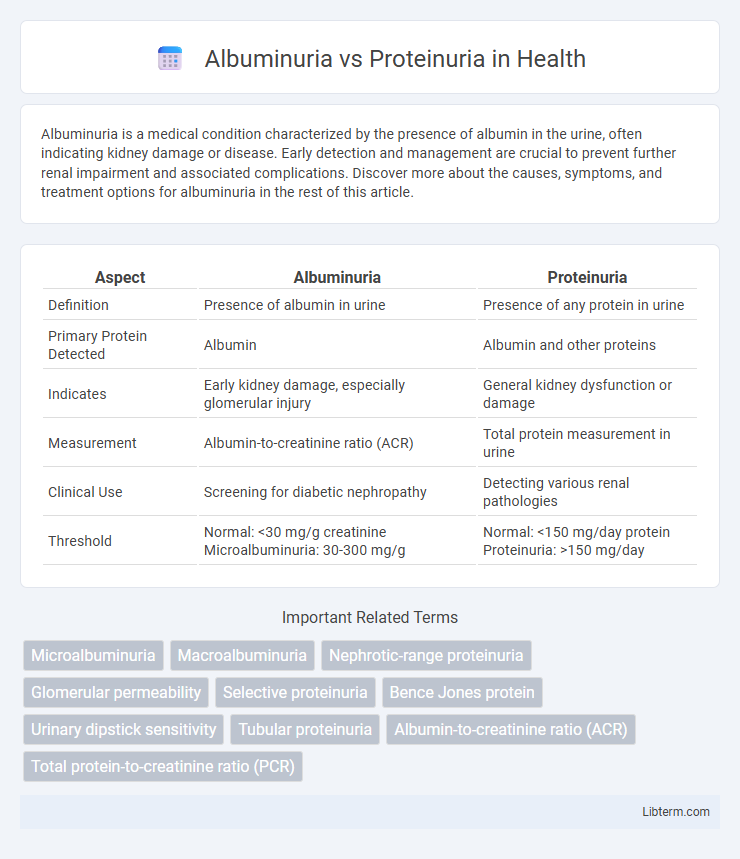Albuminuria is a medical condition characterized by the presence of albumin in the urine, often indicating kidney damage or disease. Early detection and management are crucial to prevent further renal impairment and associated complications. Discover more about the causes, symptoms, and treatment options for albuminuria in the rest of this article.
Table of Comparison
| Aspect | Albuminuria | Proteinuria |
|---|---|---|
| Definition | Presence of albumin in urine | Presence of any protein in urine |
| Primary Protein Detected | Albumin | Albumin and other proteins |
| Indicates | Early kidney damage, especially glomerular injury | General kidney dysfunction or damage |
| Measurement | Albumin-to-creatinine ratio (ACR) | Total protein measurement in urine |
| Clinical Use | Screening for diabetic nephropathy | Detecting various renal pathologies |
| Threshold | Normal: <30 mg/g creatinine Microalbuminuria: 30-300 mg/g |
Normal: <150 mg/day protein Proteinuria: >150 mg/day |
Understanding Albuminuria and Proteinuria
Albuminuria specifically refers to the presence of albumin, a type of protein, in the urine, often indicating early kidney damage or increased glomerular permeability. Proteinuria is a broader term that encompasses the presence of any abnormal amount of protein in the urine, which can result from various kidney diseases or systemic conditions. Measuring albuminuria provides a sensitive marker for kidney function and cardiovascular risk, while proteinuria detection helps identify a wider range of renal pathologies.
Key Differences Between Albuminuria and Proteinuria
Albuminuria specifically refers to the presence of albumin, a major blood protein, in the urine and often indicates early kidney damage or disease. Proteinuria encompasses a broader range of proteins found in the urine, including albumin and other plasma proteins, and can signal various kidney conditions or systemic disorders. The key difference lies in albuminuria being a subset of proteinuria, with albuminuria serving as a more sensitive marker for glomerular injury.
Causes of Albuminuria
Albuminuria is primarily caused by kidney damage resulting from conditions such as diabetes mellitus, hypertension, and glomerulonephritis, which increase the permeability of the glomerular filtration barrier. Unlike general proteinuria that indicates the presence of a broad range of proteins in the urine, albuminuria specifically reflects elevated levels of albumin, the predominant plasma protein, signaling early kidney dysfunction. Other contributors to albuminuria include infections, heavy physical exertion, and systemic diseases that affect renal function.
Causes of Proteinuria
Proteinuria is primarily caused by kidney diseases such as glomerulonephritis, diabetic nephropathy, and hypertensive nephrosclerosis, which damage the glomerular filtration barrier allowing excess protein to enter the urine. Other causes include infections, inflammation, and systemic conditions like lupus erythematosus or multiple myeloma that affect protein metabolism and renal function. Transient proteinuria may result from exercise, fever, or dehydration, whereas persistent proteinuria often indicates chronic kidney impairment requiring medical evaluation.
Clinical Significance of Albuminuria
Albuminuria specifically indicates the presence of albumin in the urine, serving as an early marker of glomerular damage and a predictor of chronic kidney disease progression and cardiovascular risk. Clinical significance of albuminuria lies in its ability to detect kidney dysfunction before significant proteinuria develops, guiding timely interventions to prevent renal failure. Monitoring albuminuria levels enables healthcare providers to assess treatment efficacy and modify therapeutic strategies for patients with diabetes, hypertension, and other renal risk factors.
Clinical Implications of Proteinuria
Proteinuria indicates excessive protein excretion in urine, often reflecting kidney damage or dysfunction, whereas albuminuria specifically denotes the presence of albumin, a key marker of glomerular injury. Clinically, persistent proteinuria correlates with increased risk of chronic kidney disease progression, cardiovascular events, and mortality, necessitating early diagnostic evaluation and intervention. Quantifying proteinuria guides treatment decisions, including blood pressure control and renin-angiotensin system blockade, to mitigate renal and systemic complications.
Diagnostic Methods for Albuminuria
Diagnostic methods for albuminuria primarily involve quantifying albumin concentration in urine through spot urine tests measuring the albumin-to-creatinine ratio (ACR), which offers a convenient and accurate assessment. Timed 24-hour urine collections provide precise albumin excretion rates, essential for confirming persistent albuminuria and monitoring disease progression in diabetic nephropathy. Immunoassays, such as nephelometry or turbidimetry, enhance sensitivity and specificity in detecting microalbuminuria, enabling early diagnosis of kidney damage before overt proteinuria develops.
Diagnostic Approaches for Proteinuria
Diagnostic approaches for proteinuria primarily involve quantitative urine tests such as the urine protein-to-creatinine ratio (UPCR) and 24-hour urine protein collection, which provide accurate measurement of total protein excretion. Albuminuria assessment typically uses the urine albumin-to-creatinine ratio (UACR), emphasizing detection of albumin as an early marker of kidney damage, particularly in diabetic nephropathy. Combining these tests allows clinicians to differentiate between albumin-specific and broader protein excretion, guiding appropriate diagnosis and treatment strategies.
Treatment Strategies for Albuminuria and Proteinuria
Treatment strategies for albuminuria primarily involve controlling underlying conditions such as hypertension and diabetes through the use of ACE inhibitors or ARBs, which reduce albumin excretion and slow kidney damage progression. Proteinuria treatment emphasizes similar approaches but may also include addressing causes like glomerulonephritis with immunosuppressive therapy or dietary protein restriction to minimize kidney workload. Both conditions benefit from strict blood pressure control, glycemic management, and lifestyle modifications to preserve renal function and prevent chronic kidney disease advancement.
Prevention and Management Tips
Albuminuria indicates the presence of albumin in urine, often signaling early kidney damage, whereas proteinuria involves a broader range of proteins, suggesting more advanced kidney issues. Preventing both conditions involves maintaining optimal blood pressure, controlling blood sugar levels in diabetes, and adhering to a kidney-friendly diet low in sodium and protein. Management strategies include regular monitoring through urine tests, use of ACE inhibitors or ARBs to reduce protein leakage, and lifestyle modifications such as weight management and smoking cessation.
Albuminuria Infographic

 libterm.com
libterm.com